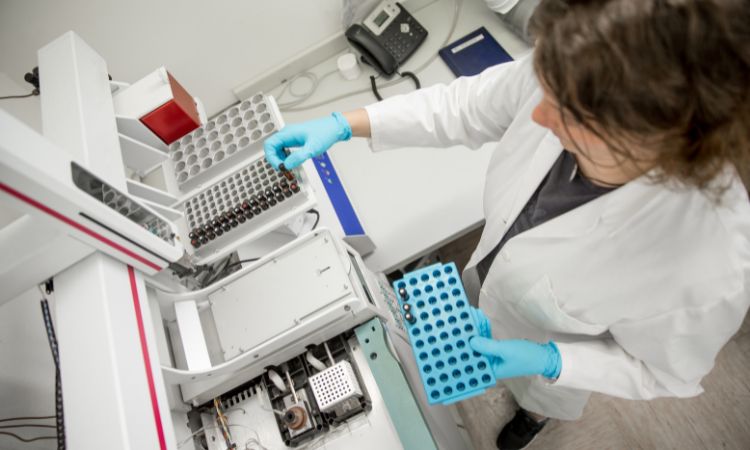The global chromatography columns market size was valued at USD 6.6 billion in 2023, driven by the increased use of chromatography in pharmaceuticals, clinical labs, and medical research. The market is expected to grow at a CAGR of 7.2% during the forecast period of 2024-2032, with the values likely to rise from USD 7.1 billion in 2024 to USD 12.4 billion by 2032. Chromatography columns play a pivotal role in achieving this growth, as they are an indispensable tool in the field of drug discovery and development. In this blog post, we will delve into the fascinating world of chromatography columns and explore how they contribute to the pharmaceutical industry’s success.
Understanding Chromatography Columns
To comprehend the significance of chromatography columns in drug development, let’s start with the basics. Chromatography is a separation technique used to separate complex mixtures into their individual components based on their chemical properties. It is widely employed in various industries, but its role in the pharmaceutical sector is particularly vital.
Chromatography columns are at the heart of this technique. They are cylindrical tubes packed with a stationary phase and used to separate and analyze compounds. These columns come in various types, each tailored to specific applications, such as High-Performance Liquid Chromatography (HPLC), Gas Chromatography (GC), and Liquid Chromatography-Mass Spectrometry (LC-MS).
Types of Chromatography Columns in Drug Development
In drug development, different types of chromatography columns are utilized depending on the requirements of the research or production process. Here’s a closer look at some of the key chromatography techniques employed in the pharmaceutical industry:
1. High-Performance Liquid Chromatography (HPLC):
HPLC is one of the most widely used techniques in drug development. It offers high sensitivity and precision in separating and quantifying compounds. Chromatography columns used in HPLC are designed to withstand high pressures and provide efficient separation of compounds, making them essential for analyzing pharmaceutical samples.
2. Gas Chromatography (GC):
GC is mainly used for volatile compounds analysis. It is invaluable in drug development for the detection and quantification of volatile impurities, residual solvents, and the analysis of essential oils and fragrances. Gas chromatography columns play a crucial role in achieving accurate results in this technique.
3. Liquid Chromatography-Mass Spectrometry (LC-MS):
LC-MS combines liquid chromatography with mass spectrometry, offering both separation and identification capabilities. It is indispensable for characterizing drug compounds, metabolites, and biomolecules. The choice of chromatography columns is critical to the overall performance of LC-MS systems.
These chromatography techniques, along with specialized columns, are instrumental in the various stages of drug discovery and development, from initial compound analysis to quality control in pharmaceutical production.
Purification of Active Pharmaceutical Ingredients (APIs)
One of the primary applications of chromatography columns in drug development is the purification of Active Pharmaceutical Ingredients (APIs). APIs are the key therapeutic components of drugs, and their purity is of utmost importance to ensure the safety and efficacy of pharmaceutical products.
Chromatography columns enable the separation of crude drug compounds from impurities, byproducts, and unwanted substances. This purification process ensures that the final drug product meets stringent quality standards. In essence, chromatography columns are the gatekeepers of drug purity, making them indispensable in the pharmaceutical industry.
Analyzing and Characterizing Compounds
Chromatography columns also play a crucial role in compound analysis and characterization. During drug development, researchers need to identify and understand the chemical properties of compounds under investigation. Chromatography techniques, coupled with specialized columns, provide precise separation and isolation of individual components within a mixture.
By analyzing the separated compounds, researchers can determine their chemical structures, assess their purity, and identify potential impurities or degradation products. This information is vital for selecting promising drug candidates and ensuring their safety and effectiveness.
Quantitative Analysis and Validation
Quantitative analysis is another critical aspect of drug development, and chromatography columns are essential tools in this regard. Researchers need to accurately determine the concentration of drug compounds in various formulations, from early-stage drug candidates to the final pharmaceutical products.
Chromatography columns facilitate quantitative analysis by allowing precise separation and quantification of target compounds. Moreover, the data generated using chromatography columns must adhere to rigorous validation and regulatory standards to ensure the reliability of results. These columns contribute to the validation process, making them indispensable for regulatory compliance in the pharmaceutical industry.
Case Studies and Success Stories
To illustrate the practical impact of chromatography columns in drug development, let’s explore some real-world case studies and success stories:
Case Study 1: Development of a Breakthrough Cancer Drug
In the development of a groundbreaking cancer drug, chromatography columns were used to purify the active compound from a complex mixture of reaction products. This purification process was essential to meet the strict quality standards required for clinical trials, ultimately leading to the drug’s approval and improved cancer treatment options.
Case Study 2: Ensuring the Safety of Pediatric Medications
Chromatography columns played a crucial role in the analysis of pediatric medications to ensure their safety and efficacy. By accurately quantifying active ingredients and identifying potential contaminants, these columns contributed to the development of child-friendly formulations that met regulatory requirements.
Case Study 3: Accelerating Drug Discovery
In a drug discovery program targeting infectious diseases, chromatography columns enabled rapid compound screening and characterization. This accelerated the identification of potential drug candidates, expediting the development process and increasing the chances of finding effective treatments.
Challenges and Future Trends
While chromatography columns have been instrumental in drug development, they are not without challenges. Researchers often face issues such as column degradation, selectivity, and sample compatibility. The industry continually addresses these challenges through innovations in column design, materials, and analytical techniques.
Looking to the future, chromatography columns are expected to remain at the forefront of drug development. Emerging trends include the development of sustainable and eco-friendly column materials, automation and robotics for high-throughput screening, and the integration of artificial intelligence and machine learning for data analysis and optimization.

